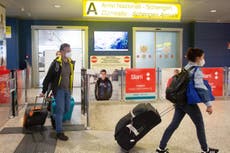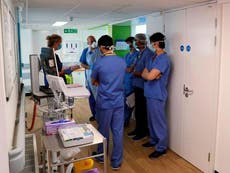The latest jobs numbers are unexpected. This could be very good news for our future after coronavirus
A proper analysis of where we are now paints a surprisingly positive picture

Economists excel (get it?) at top-down analyses of financial and macro trends — but most know little about specific industries, and pay them little attention. With that in mind, let’s talk about Friday’s not-at-all-as-expected jobs report — a 13.3 percent unemployment rate, as 2.5 million jobs were somehow added even as 2 million or more people applied for unemployment insurance each week. On top of that, average hourly incomes are falling, but only thanks to a resurgence in low-wage jobs previously lost.
Now let’s talk about how fast it can get better — and why.
To be sure, nothing you’re about to read is certain. All of it depends on the spread of the coronavirus slowing to a trickle — and there are a fair number of reasons it might not. It may or may not get unemployment back into single digits by year-end, as Labor Secretary Eugene Scalia predicted on Wednesday. But the case for relative optimism begins with looking hard at where the biggest chunks of layoffs are coming, and the underlying condition of the industries that have been shrinking.
One ice-cold observation lies at the heart of the bull case: That since the biggest layoffs are in low-paying fields, they’ve had less impact on consumer spending than they might. And, if this report, based on surveys done almost three weeks ago, is accurate, the lower-income workers are landing much faster than anyone expected — economists surveyed by Dow Jones expected the unemployment rate to be 19 percent or higher. There are signs that even some of the most discretionary spending hit by the virtual shutdown of American business will come back relatively quickly as we reopen. Which would let many of the industries that depend on consumer spending recover faster than you may think.
This is very different than the recession after the financial crisis. Back then, the 9 million net lost jobs were concentrated in high-paying fields like finance, which lost just 262,000 of its 8.6 million positions in April and gained 33,000 in May.
To understand this argument, understand where the layoffs in March, April and May have come from — and ponder how those industries really work. In the two months combined, 19.6 million net jobs have been lost, according to the Labor Department.
But where? And how do those industries work? Let’s look at them from the most encouraging to the least — while bearing in mind the whole time that our point is to understand how the most benign outcome could occur.
Start with healthcare. The industry accounted for 2.1 million lost jobs in April but added 390,000 in May, the Labor Department reports. Of those, 1.1 million were in doctors’ offices and ambulatory surgery centers which closed, or all but closed, during shutdowns. Half a million more layoffs hit dentists’ offices in April alone, and more came at hospitals that deferred as many non-coronavirus patients as they could. If you needed a hernia fixed or a knee replaced, you could wait.
As they reopen, there’s little reason to think they’ll stumble much. Why? Because the federal government — the most liquid entity in creation — pays for about 40 percent of US healthcare. Significantly more than half of those workers will be just fine; people with health insurance will have little reason to defer care as their doctors and dentists reopen. Half of all dental workers were recalled in May already.
The next really big slug of April layoffs — 1.4 million — come from manufacturing, including almost 400,000 in auto and parts-making. Vehicle sales are showing signs of life, with May sales up 42 percent from April (though well below May 2019, still). General Motors hopes to get North American production back to pre-Covid levels by the end of June, CEO Mary Barra told an investor conference Wednesday. There are bumps (like sporadic cases of factory workers who test positive) and challenges (like rekindling sales to auto-rental companies, which are in trouble) — but there’s also a decent outlook for a lot of jobs to return soon.
You can see this happening already: 225,000 manufacturing jobs came back in May, 27,700 of them in autos and parts. Electrical equipment, furniture and food manufacturing also snapped back. Restoration Hardware’s upbeat earnings report Thursday was a clue something was brewing in furniture — the expensive chain’s customers didn’t get laid off much, and apparently didn’t stop spending as much as defer it.
Then take the 1.6 million jobs lost in government, which was still shrinking in May — most of them in state and local governments that stand to be propped up by the next federal stimulus when it arrives. Nearly half of those are in state and local education — teachers, mostly — laid off when schools went online-only. Schools will be back by September, so long as Washington plugs the gap in state and local revenues. And so will most other state and local workers who were furloughed.
Then there’s construction, another sector crippled by stay-at-home orders, at a cost
of 975,000 jobs in April — 464,000 of which were recovered in May. New home sales were actually pretty good in April, and renovation contractors were hiring by May for both residential and commercial building.
Now, what has to happen to make this hopeful scenario stick?
First, the next stimulus has to pick up state and local governments, so government employment can snap back before state tax revenues do. Some Senate Republicans are balking at this, but they need to get over themselves. This remains the worst recession since the Depression, and it’s not over.
Second, the restaurant industry — which lost a staggering 5.4 million jobs in April but recalled 1.4 million workers in May (which must have been due to federal assistance in the CARES Act) — needs consistent access to credit as restaurant owners try to reopen this month. It’s going to be hairy for a while, with eateries only allowed to fill half their seats or even fewer. The Federal Reserve has been the most consistently outstanding part of the federal response to Covid, and is likely to make sure as many restaurants as possible make it to the point where people feel comfortable going out again.
More actions than these will be needed, of course. University of Michigan economist Betsey Stevenson points out that, due to a methodological error, the real unemployment rate is likely about 3 points higher — but still way below where economists thought it was. That’s a story for another time.
Today, the basics are that the damage to the economy appears to be a lot more superficial than it did even a few hours ago. And that the economy looks a lot different when examined from the industries up, rather than from financial indicators down.




Join our commenting forum
Join thought-provoking conversations, follow other Independent readers and see their replies